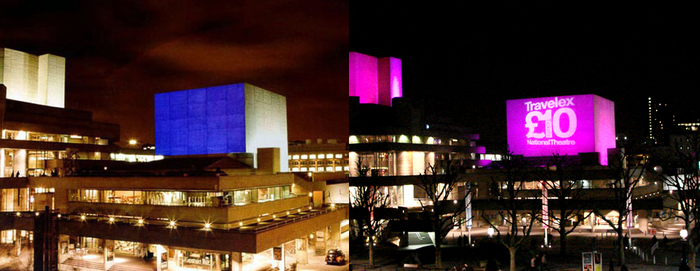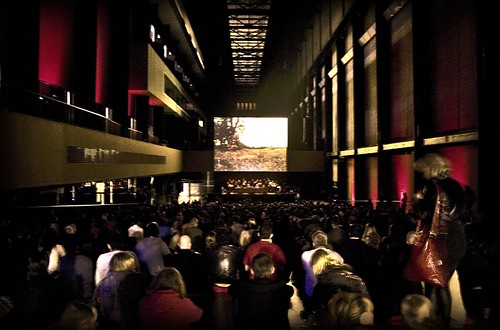A couple of months ago, I was contacted by producers from Backlight, an investigative documentary TV series on the Dutch public broadcaster VPRO. They were trying to locate and interview Scott Sforza for a program set for the 5th anniversary of the invasion of Iraq. [I’d tried and failed to contact Sforza for my Cabinet Magazine article about his work last summer.]
The episode aired the other night, and it’s online now, and well worth the watch, even if you don’t speak Dutch; most of the talking heads–including me–speak English.
It’s amazing on many levels, not the least of which is the sheer impossibility of an in-depth, retrospective investigation called “The Selling Of The War” ever airing on an American news network. VPRO focused in on a couple of very specific elements of stagecraft, manipulation, and deceit from 2003: Colin Powell’s UN speech; the White House-built stage at the CENTCOM media center in Doha, Qatar; and the Coalition press conference where Gen. Tommy Franks announced the invasion, which had a controversial–and damning–Dutch hook.

I did my Sforza fanboi spiel about human wallpaper, and it turns out that among the human wallpapers Franks pulled on stage and introduced as a Coalition partner was a Dutch colonel, Jan Blom [on the far right above]. But the Netherlands were not part of the Coalition. The guy was a NATO public affairs officer, who was grabbed at the last minute to provide balance and camo variety to the backdrop. Naturally, word of the scandal that erupted in Holland after Blom’s appearance has not yet penetrated the American heartland.
The two guys in the middle were Franks’ equals from the US’ actual Coalition partners, Great Britain and Australia, who were only told at the last minute by a White House operative that they would not be participating in the press conference. The guy on the far left was another prop, a Public Affairs guy from Denmark. So the stagecraft managed to simultaneously insult and dissemble. That’s Rumsfeld’s new lean&mean Army!
Perhaps it’s really a minor point, but it’s just one of many that show how deceptive and manipulative the administration was in the crucial period of the run-up and the invasion. Again, try to imagine a US network news show of any kind devoting 30 minutes to pull apart such a lie. [Actually, it’s probably half that time; there was a great deal of time devoted to former Powell Chief of Staff Lawrence Wilkerson’s explanation of how the UN WMD speech came together, something that has been covered in the US.]
So anyway, happy anniversary!
Program page: Tegenlicht: De Verkoop van een Oorlog [vpro.nl]
Watch the episode online via real player [vpro]
Author: greg
Save The Neutra! Sell The Neutra!
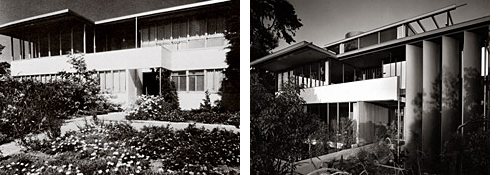
Holy smokes. On Archinect, Orhan has launched into a free-ranging, fantastical, and ill-informed lamentation over the impending doom that the callous, uncaring, neglectful architectural aficionado community is somehow foisting on the Neutra VDL Research House in Silverlake:
I wouldn’t elaborate on it at this finger pointing tone, but this is a city where you hear the words “inspired by Neutra” in various forms and places such as architects’ web sites, in countless design blogs, in real estate ads and of course in the circles of armchair design writers.
What abandonment.
Pages of coverage, with wall to wall color pictures, for so called Neutra specialists, when they re-build or renovate million billion dollar properties, which the architect and his pupil did years ago with clear aluminum sash and placed the glass in the right place. But, they don’t mention the VDL House, where it were all dreamed up and put to experiment.
…
After Mrs. Neutra’s death, the decay gradually became visible and impossible to hide.
Rudolf Schindler became the new hero of the Austrian invasion and people start to forget about Neutra for fashionable correctness. The same community who raised hell over a building next to MAK protected Schindler house, knew nothing of VDL house’ neighbors or didn’t care. Absurd and campy cliches like “Neutra was not as good as Schindler’ became part of groupie conversations in hipster parties.
It may very well be important for Neutra’s legacy; for the moment, let’s assume that it is. But the VDL Research House’s history is so deeply troubled, that the only conceivable way to save it is to sell it.
The current owners and stewards of the house, California State Polytechnic University, Pomona’s Dept. of Environmental Design [ENV], have proved utterly incapable of either using, maintaining, preserving, or promoting the Research House from the moment they were promised it in 1979 and from the moment they took possession of it in 1990.
According to the house’s own website, the “Urgent Campaign for Neutra VDL” has two purposes: to raise $30,000 immediately [by Oct. 2008, oops] for such basic operating expenses as insurance and utilities, and to raise $2 million, half for major repairs required after years of neglect [also resulting from original design drawbacks like putting a reflecting pool on the freaking roof]; and half for an endowment to provide ongoing operating expenses, and funds for programming and events for Pomona’s students and the broader public.
If this money can’t be raised, what will happen? According to the website, “the building complex is threatened with closure, possible sale to a private party, and quite possibly permanent loss of public and educational access.” Ooh, what abandonment.
The University that has neglected and underfunded the house for the 18 years since it received it, that apparently can’t fundraise successfully to support the house, and that lets major structural damage occur on their watch is now making an urgent plea for emergency funds. Meanwhile, they’re essentially holding the wounded building hostage, letting its conditions deteriorate until the inevitable finally happens, and the building is sold–and saved, finally–to some other entity who has a real commitment and the means to preserve it. And the only possible downside is “possible” loss of access.
The University generally and the Department of Environmental Design [ENV] specifically have demonstrated their total lack of commitment and interest in keeping the VDL Research House. In 2005, the University’s president launched a Priority & Response project to focus the school’s strategic and budgetary goals and needs. Here is a portion of a recommendation from the ENV Dean’s Office:
Over the past four years [i.e., since at least 2001. -ed.] ENV has attempted to raise funds for repairs to VDL, without much success. One impediment to fundraising is that the house is already named. Further, the VDL property serves a small portion of the ENV population of students and faculty. Since the house is 35 miles from campus, it is not a convenient location for seminars, weekly classes, or even receptions. While the College of Environmental Design recognizes this home as an icon of modern architecture, it is a much lower priority for fundraising than other projects, including a new building for the college, endowed professorships, scholarships, and a faculty development fund.
At the time of that recommendation, the estimated cost of needed repairs was $350-500,000, or half what is estimated today. The irony in several faculty statements in the P&R is not sweet:
[O]ur College is recognized nationally for its program in Historic Preservation, which has an emphasis on works of the twentieth century. The VDL house is a central feature of this program.
If that’s at all true, then the College should have its accreditation reviewed, because despite presiding over a modernist landmark built largely of manufacturer-donated materials, a pool of cheap-to-free labor and expertise, and [until very recently] a real estate/renovation/preservation boom, they have managed to push the Research House to the brink of disaster.
Proving themselves so unworthy, if the school and the Neutra fans in it honestly give a damn about the house, they’ll work to find it more capable owners, pronto.
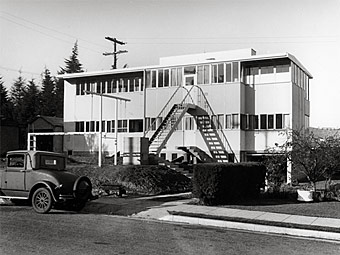
1932: VDL I, by Richard Neutra
But is the house really so special it needs saving? It is certainly a Neutra design, but which design? And for that matter, which Neutra? It seems to be a question no one in the architecture community wants to bring up, lest it hurt the house’s chances for survival.
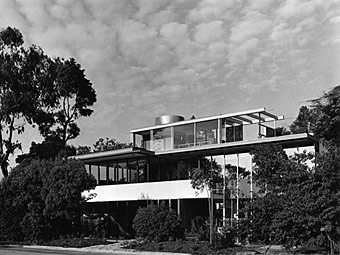
1963: VDL II, by Dion Neutra, I mean, “Richard and Dion Neutra”
But the basic timeline and the facts of the house are not in dispute: Richard Neutra built the front, studio/residence section of the house in 1932, and he added a courtyard house in back in 1940. The front house burned down in 1963, and a new house, with a new design, using new materials, was built on the foundation in 1965-6. The architect of record was Dion Neutra, Richard’s son, who had joined his father’s architecture practice.
According to Dion’s explanations of his working method with his aging father, and looking at at least some of the drawings for the Research House II, Neutra pere watched the fils design, and then gave him feedback. A glance at photos of the 1932 and 1965-6 incarnations of the house show dramatic differences. I’ll leave definitive historical judgments to the experts, but to my mind, the Neutra design needing saving right now is an Early Dion approximation of a Late Richard.
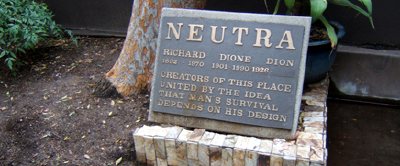
From self-serving online chats with students, to his delusional price comparison of his father’s office building to the paintings of “Klimpt & Pollack,” to the outsized bronze plaque/tombstone declaring his intention to have his ashes scattered in the VDL courtyard, Dion Neutra’s dogged insistence on inserting himself repeatedly and aggressively into his father’s legacy might be making it difficult for more clear-eyed, thoughtful preservation and scholarship to take root. It’s worth noting that Dion is not publicly involved with the VDL campaign in any way; his younger brother Raymond, a retired physician, is the family representative.
And while the Neutra family is to be commended for their dedication and efforts, you kind of wish–and by “you,” I mean “I”–that someone in the field would sit them down and talk to them frankly about the choices they need to make between actually preserving their father’s built legacy and perpetuating a well-meaning but disastrously flawed idea without a plan that puts that legacy at risk.
Frankly, the committees, boards and friends of Neutra VDL don’t look like they have the capacity to raise $2.03 million, and until they realize that themselves, the house will just deteriorate further. The only solution they seem able to provide is an introduction to an architecture collector who will take the property off their hands. They should hop to it.
Neutra VDL Research House v. Hard Times [archinect]
Neutra VDL Studio & Residences site [neutra-vdl.org]
Previously: Neutra For Sale: Calling Michael Govin [sic]
Tibet Is Next To China

My daughter got Tibetan necklaces for Christmas when she was two. I asked her if she knew where Tibet was. And then I told her, “It’s next to China.”

image of Buddhist monks in Xiahe, Gansu province [in China] showing solidarity with protesters in Lhasa on the occasion of the 49th anniversary of the Tibetan rebellion against the Chinese invasion, which ended in the Dalai Lama’s fleeing the country: AFP/Getty via NYT.
Tibetan Government in Exile [tibet.com]
Ceci N’est Pas Un Satelloon
But darned if it isn’t pretty damn close. La Géode is a mirrored geodesic dome housing a hemispheric Omnimax theatre. It’s part of the Cité des Sciences et de l’Industrie, a science museum opened in 1986 in Parc la Villette, which I confess, I only knew as the site of Bernard Tschumi’s red follies. [There are a couple visible in the background here, and judging from this photo from another angle, they’re rightupthere next to the dome.]
At 34m across, Adrien Fainsilber’s stainless steel-clad Geode is the nearest approximation to the physical presence of a Project Echo satelloon that I’ve found. [Thanks to Stuart, actually, who tipped me to the recent post on extremely impressive shiny balls on deputy dog.]
Fainsilber’s site has more pictures, including the grainy-nice snap of the Geode nearing completion. and this amusing explanation:
Symbole de l’Univers, le reflet des nuages suggère la forme des continents et offre une vision immatérielle de l’environnement.
L’écran hémisphérique de 26m de diamètre de la salle de spectacle a engendré la forme sphérique de l’enveloppe.Symbol of the Universe, the reflection of clouds suggests the form of continents, and offers an immaterial vision of the environment.
The hemispheric screen of 26m diameter in the salle de spectacle [heh] engendered the spherical form of the envelope
I love it, a loopy mix of grandiose over-symbolism and bureaucrat-pleasing rationalization. As if the shiny steel awesomeness of the dome was somehow just the unavoidable by-product of the program the humble architect received. [Qu’est ce qu’on a pu faire? C’est logique.] Sure beats the “but it’s art!” pitch that was the last straw for the suits backing the Pepsi Pavilion.
Also, it’s an amusing stick in the eye of the deconstructionist, “form before function” conceit that Tschumi and collaborator [sic] Jacques Derrida put forward for the rest of the park.
I don’t know the story of the creation of Parc de la Villette, but Tschumi sounds like the Robert Irwin to Fainsilber’s self-important Richard Meier. Looking at the landscaping, la Geode has gone from being a Symbol of the Universe to just one stop of Tschumi’s David Rockwellian Cinematic Promenade. Or to the electron on a hydrogen atom. Which, as I zoom in with the all-seeing Google Eye to watch the picnickers in the Parc, i realize is so true. What if the whole universe were just an atom under the fingernail of a giant?
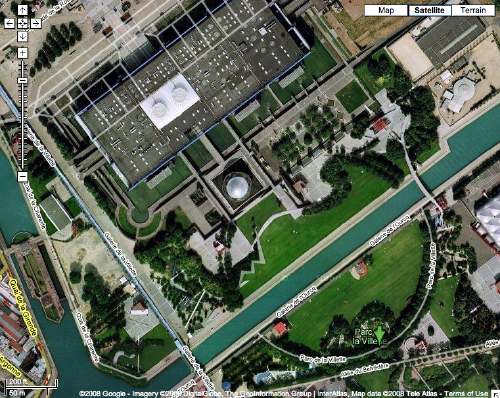
extremely impressiv shiny balls [deputydog.com]
Fainsilber > Realisations > CSI [fainsilber.com]
CSI and la Geode, and guests reading Le Monde, apparently, and letting their kids run wild [google maps]
Metaphysics of Parc de la Villette [gardenvisit.com]
Angel Dust, 2000, Jeremy Blake
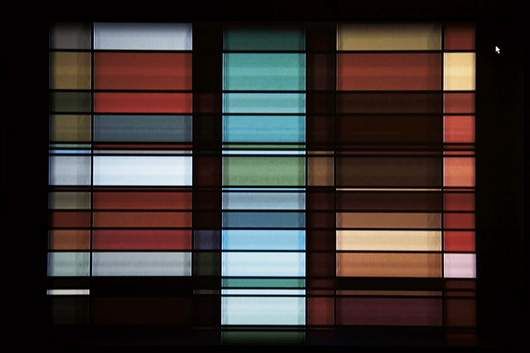
From “Jeremy Blake in Three Parts,” written by editor/curator Bennett Simpson for PS 1’s “Greater NY” show. In 2000, Blake’s 20-min. digitally animated abstraction titled Angel Dust was in both the harried, hasty “Greater NY” and the Pompidou’s “Elysian Fields”, a sublime show for which Simpson curated an incredible sound program:
I.
In the new art game, machine language is the best kind of pragmatism. Because you’ve never had so many options, your tools should work for you. There is still such an impoverished discourse around art made with “new media” that it benefits everyone to be dexterous (or at least flexible). Jeremy Blake tells me it took months to program his latest digital animation Angel Dust. I believe him. Line for line, the amount of coding, sequencing, and editing involved is staggering. As is more and more the case with art’s flirtation with technology, the hours logged and the efforts involved are right on the surface — and in a way, this is part of the point. Skill is transparent. Insofar as Angel Dust can be called abstract art, its abstraction is one of trial and error, micro-production, shortcuts, good fortune, lots of practice, lots of knowledge, and an appreciation of possibilities. I’m not only speaking about the animation’s formal qualities or its methods of production. If abstraction is now the domain of distributed and integrated systems of information, then the function of Angel Dust’s content — its seething Mondrian grid, its Burbank-rolled narrative tics, and its psychedelia — is no different from its code. Blake makes programmed art works: the what and how are symptomatic of each other.
The other two parts are after the jump. An edition of Angel Dust is coming up at auction at Phillips in a couple of weeks.
Solar Balloons Not Quite Satelloons
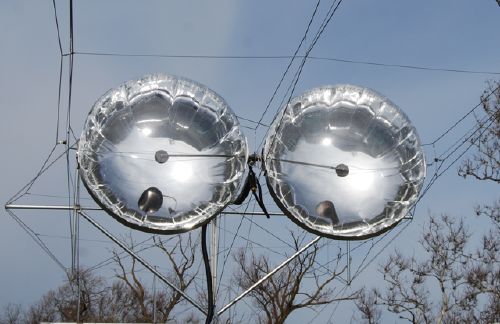
So I’m staring at these Solar Balloons by Coolearth Technology, caught like a deer in some headlights [actually, with this pair, maybe it’s “caught like a spring breaker in some headlights, but whatever], and I can’t figure them out.
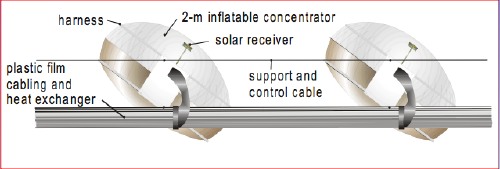
Then I get it: one half of the balloon is clear; the parabolic–or parabola-like, anyway–reflector part is the inside surface of the other, opaque side of the balloon. 2-meter diameter. Not Satelloon-scale, but still, it’s good to know it’s out there.
Solar Balloons from Coolearth Technology [coolearthsolar via inhabitat]
Derek Jarman’s Blue and Travelex’s Pink
In 2000 curator Scott Burnham organized a projection of Derek Jarman’s last film, Blue, on the facade of the National Theatre. Visually, the film consisted of a monochrome, electric blue inspired by Yves Klein. The audio, which included readings of Jarman’s journals, was broadcast via localized, low-frequency radio.
The photo on the right was from 2007. After the successful proof of concept, the National Theatre could get down to business.
Derek Jarman’s In The Shadow Of The Sun
I’ve had Derek Jarman on the brain the last couple of weeks. Isaac Julien’s spectacularly moving documentary Derek got distribution at Sundance and won awards at Berlin; Julien’s curated show of Jarman’s work opened at the Serpentine.
And I found photo accounts of a live performance of Throbbing Gristle’s live accompaniment of Jarman’s super-8 shorts, In The Shadow of The Sun, last fall in the Turbine Hall at Tate Modern. [above].
TG provided the original soundtrack in 1980-81. They played to a packed house last May as part of the Tate’s Long Weekend series of events and performances. If you liked Throbbing Gristle’s kind of assaultive ambient 80’s music, this was the kind of assaultive ambient you liked. They apparenty provided cushions, since no one who listened to TG back in the day likes to sit on cold, concrete floors anymore.
Derek Jarman’s Music Videos
While is ridiculously easy to soak in Derek Jarman’s work in the UK at the moment, it’s nigh impossible to find anything programmed in the US. Fortunately, one of Jarman’s most easily accessible bodies of work–music videos–is also one of his most readily available. For some reason, it’s also one of his least recognized critically. [I hope someone will prove me wrong by sending links or references to a nice article or exhibition of Jarman’s music videos.]
Cross referencing the incomplete list on Wikipedia with the partially obscured filmography in Rowland Wymer’s 2005 critical essays collection, Derek Jarman, I think I’ve come up with a complete list. Then I searched them out on YouTube. Everyone knows The Smiths and the Pet Shop Boys, but did you know Jarman directed the video for Wang Chung’s “Dance Hall Days”?
From A Glimpse To A Panorama
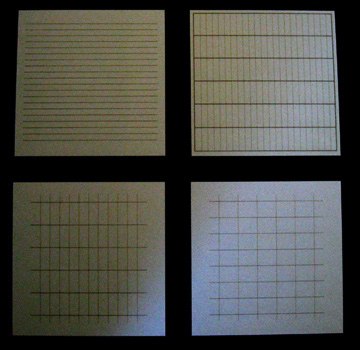
If anyone’s life’s work could have at once so little and so much to show for it, it’s Agnes Martin. From Brian Droitcour for Artforum:
This brisk tour of Agnes Martin’s career–forty years in twenty drawings–is anchored by On a Clear Day, 1973, a series of prints offering thirty ways to regard the square.
…
In the 1970s, Martin pared down an already spare vocabulary. These prints are a glimpse of her shifting priorities, and the drawings around them protract that glimpse into a lifelong panorama.
From the gallery’s press release for the show, a little background:
In the late 1950’s Agnes Martin’s landscapes and biomorphic surrealist works transformed into abstraction and what would eventually become her signature examination of rectangular grids within a square format. Her work ranges from early tight grids to the opening up of forms to wider rectangles. Disillusioned with New York, Martin moved to New Mexico in 1967 and abandoned painting. When she resumed her work around 1974, the earlier primarily black and white palette modified to include monochromatic washes of subtle pastel colors, perhaps influenced by the New Mexico landscape. While Martin’s abstract repetitive forms have been associated with Minimalist style, she considered Minimalism impersonal and over-intellectual, preferring her work to be characterized as Abstract Expressionist due to its more personal and spiritual nature. Inspired by emerging concepts of Taoism and Zen Buddism in the 1950’s, Martin, like many of the Abstract Expressionists, sought a style that transcended the material world and spoke more of the mind and the experience of the sublime.
On A Clear Day was instrumental in Martin’s own retrospective re-evaluation of her work and was apparently a catalyst of sorts for her resumption of painting in 1974. For details, check out Lynne Cooke’s essay accompanying the Dia’s exhibition of pivotal paintings from 1974 – 1979.
Though it might be tempting, in the absence of any apparent content beyond the grids, to investigate and catalog the variations and details that were surely deliberate decisions on Martin’s part, Cooke argues that this is not what Martin was after when she began painting again:
her endeavor would not be to mobilize the viewer in a process of “looking for” but to immerse the solitary, stationary spectator in an indeterminate, luminous space, in attentive contemplation, “looking at.”
Brian Droitcour reviewing “Agnes Martin, Works On Paper” at Peter Blum Soho trough March 15 [artforum]
Peter Blum Gallery Soho [peterblumgallery]
“To The Islands, Agnes Martin Paintings, 1974-1979 [diacenter.org]
[image via portlandart.net]
Faster, Bulletin Kill Kill!
Alright, does anyone have a screenshot of the victim?
Apparently, the AP erroneously reported at 6:35EST that Bush resigned over, of all things, plagiarism. It’s like getting Capone for tax evasion.
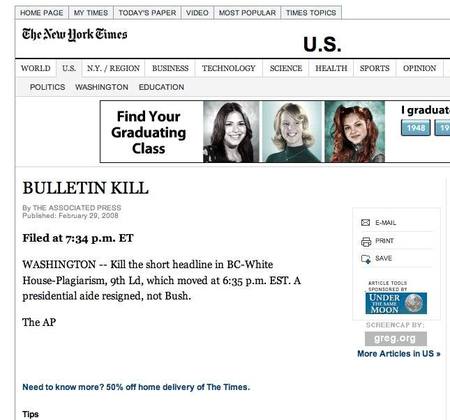
whoa, it’s 2 min, later, and it gets even more dire-sounding: “A kill is mandatory. Make certain the short headline is not published.”
Do these folks know their mic is on?
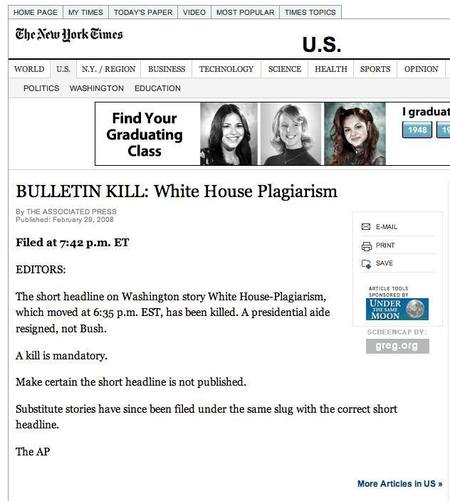
BULLETIN KILL [ap/nyt]
To See This Weekend: John Powers @ Virgil deVoldere Gallery
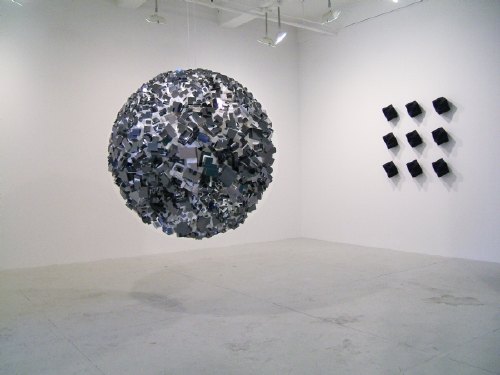
As he was working on it the last few months, my friend John Powers kept hinting that his upcoming show would have a bit of the Deathstar and a bit of the disintegrating disco ball. He’s not kidding. The Force is strong with this one.
Empire, 45-in diameter, styrofoam and anodized aluminum, at Virgil de Voldere Gallery, the Chelsea Arts Bldg on 26th st through Mar. 29 [virgilgallery.com]
John Powers’ portfolio site [johnpowers.us]
The Moon Museum
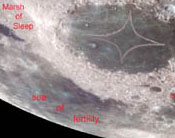 Holy ^%$&! Man Smuggles Art To The &%#$ing Moon!
Holy ^%$&! Man Smuggles Art To The &%#$ing Moon!
In 2003, Craig Kalpakjian proposed a series of Earthworks-style drawings that would be executed on the surface of the moon, like the Nazca Lines or 60’s bad boys Michael Heizer’s and Dennis Oppenheim’s desert drawings. He called them Moonworks.
Now I find out there was already an entire Moon Museum, with drawings by six leading contemporary artists of the day: Andy Warhol, Robert Rauschenberg, David Novros, Forrest “Frosty” Myers, Claes Oldenburg, and John Chamberlain. The Moon Museum was supposedly installed on the moon in 1969 as part of the Apollo 12 mission.
I say supposedly, because NASA has no official record of it; according to Frosty Myers, the artist who initiated the project, the Moon Museum was secretly installed on a hatch on a leg of the Intrepid landing module with the help of an unnamed engineer at the Grumman Corporation after attempts to move the project forward through NASA’s official channels were unsuccessful.
Myers revealed the exhibition’s existence to the New York Times, which published the story Nov. 22, 1969, two days after the Apollo 12 crew had left the moon–and the Intrepid–and two days before they arrived back on earth. Here’s the photo from the story:
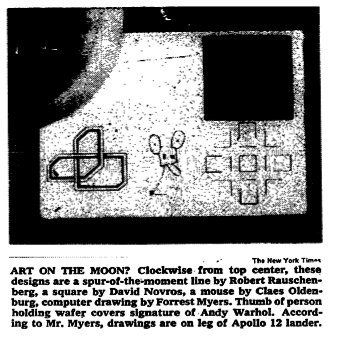
According to Myers, who was involved with E.A.T. on the Pepsi Pavilion project at the time, the six drawings were miniaturized and baked onto an iridium-plated ceramic wafer measuring just 3/4″ x 1/2″ x 1/40″, with the assistance of engineers at Bell Labs.
According to the Times, the artworks are, clockwise from the top center: Rauschenberg’s wavy line; Novros’ black square bisected by thin white lines [in 1969, Novros also created the incredibly rich, minimalist fresco on the second floor of Judd’s 101 Spring St]; a computer-generated drawing by Myers; a geometric mouse by Oldenburg, “the subject of a sculpture in his current show at the Museum of Modern Art” [a sculpture which is in MoMA’s permanent collection, btw]; and a template pattern by Chamberlain, “similar to one he used to produce paintings done with automobile lacquer.” Warhol’s contribution, which is obscured by the thumb above, is described as “a calligraphic squiggle made up of the initials of his signature.”
Actually, it’s a drawing of a penis. Here are some other photos by Frosty Myers, published, I believe, with a 1985 Omni Magazine article by the arts writer Phoebe Hoban. That would be the Warhol Penis there in the upper right.
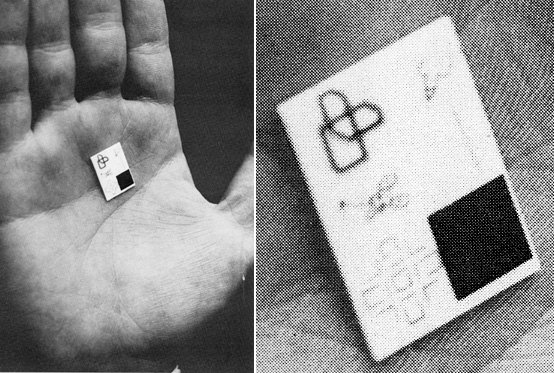
As the NASA spokesman told the Times when asked about the Museum infiltration, “I don’t know about it. If we had been asked, it sounds like something we’d have very much interested in [sic]. If it is true that they’ve succeeded in doing it by some clandestine means, I hope that the work represents the best in contemporary American art.”
[emphasis added for ironic amusement, though to Myers’ credit, it turned out to be a pretty good grouping of artists to have involved.]
But is it conceivable that someone could have smuggled dirty pictures onto a mission to the moon? Actually, yes. Even if Warhol hadn’t sent that penis to the moon, Apollo 12 would still have achieved the first known incident of lunar nudity.
The back-up crew for the A12 mission surreptitiously inserted reduced photos of Playboy centerfolds into the flight crew’s fireproof plastic cuff checklists which were only discovered about 2.5 hours into their first moon walk. [if you’re at work, that first link is to nasa.gov, and the second is to playboy.com. The same scans are available at both sites, though NASA has conveniently embedded theirs in a PDF.]
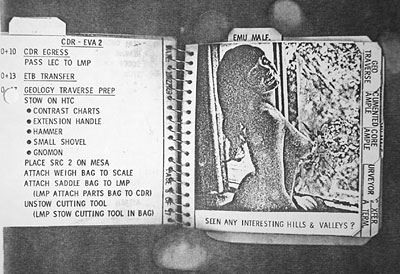
In addition to the six drawings, the Moon Museum also acquired a large collection of photographs; astronaut Alan Bean accidentally left several rolls of undeveloped film behind on the lunar surface. The checklists came back with the astronauts.
Related: Frosty Myers, the SoHo pioneer, had a retrospective exhibition last November-December at Friedman Benda Gallery in Chelsea. [friedmanbenda.com]
Also, he had a sitdown with my favorite crazy at The Grey Lady, design/home writer Joyce Wadler. [nyt]
No Kidding, It’s A Small World
After riding the It’s a Small World ride half a dozen times on my first trip to Disneyland, I sent off for information on how to become an Imagineer. I was seven.
Yet somehow it’s taken me until this week to realize that the treacly animatronic Mary Blair masterpiece was originally created by Walt Disney at the behest of the Pepsi-Cola Corporation, which wanted a popular pavilion for the 1964 New York World’s Fair. Disney was apparently commissioned to design four corporate pavilions that fair.
According to Billy Kluver’s long, rambling account/apologia published in the 1972 book, Pavilion, Pepsi was in talks with Disney to produce the 1970 pavilion in Osaka, too, but Disney’s budgets were orders of magnitude too high. Disney’s withdrawal in late 1968 left Pepsi with an empty pavilion to fill, and it created the opportunity for E.A.T. to get involved.
It’s a small world after all.
Joep van Lieshout: Those Who Can’t Do, Make Art
Now I’ve been a fan of Joep van Lieshout’s work for a long time, even if a lot of it’s too irreverent or too bombastically oversexualized to evangelize about regularly. [“You see, mom, he builds these room-sized uteruses with built-in bars…”]
But listening to his talk at Tate Modern last fall, it wasn’t his successes so much as his failures that stuck in my mind. The arc of the interview with curator Marcus Verhagen was the failure of AVL-Ville, Atelier Van Lieshout’s attempt to turn its Rotterdam waterfront studio complex into an independent, anarchic state, and how that flirtation with utopianism eventually led to the artist’s current dystopian fascination. The artist then explained his concept for a hyper-capitalist, sustainable, totalitarian slave city with a population of 200,000 that produces EUR7 billion in profits each year. So far so good [sic].
When it got to the Q&A, though, someone asked van Lieshout if his zero-impact utopia, with its organic urban farming, &c., was so great, why not keep developing it? He dismissed the idea, since it would involve actually running the thing, then it’d take expertise, and attention, and involvement with the bureaucracy, and anyway, who knows if it really works? [Obviously, I’m paraphrasing here.]
The gist of his reply, though, was reality’s too hard, so he’s leaving it as art.
Then when someone lobbed a generous softball of a question by describing his structures and installations as “cinematic,” van Lieshout punted again. Though he, too, conceives of his work as the sets upon which some unspecified drama unfolds, he never makes films, because he “doesn’t know how.”
I’d always thought of AVL-Ville as something of a conceit, but I had no idea how utterly dependent it was on the benign neglect of Dutch bureaucrats, and I certainly didn’t know how quickly and utterly it folded when faced with the most rudimentary challenge. And similarly, when even a clueless yahoo like me can figure out how to make a movie, expertise and technology just are not credible obstacles anymore.
Sure, art is not, by definition, the real world, but I’d always somehow considered it to be superior in its distinctiveness. And yet here was van Lieshout’s art being defined by its impractical, unproved inferiority in one case, and as the refuge for ignorance in another. We unconsciously give Art a presumption of cultural significance that, what do you know, it may not automatically deserve.
Too often, it gets considered only on its own terms, in a bubble, a world [sic] apart from the real world. It’s why the mediocrity of an artist like Mariko Mori gets taken seriously when it’s dwarfed technically and philosophically by CG and narratives of the best films and video games. Or why a piddly little spiral jetty is raised to masterpiece status while the US Army’s vast earthworks at the nearby Dugway Proving Grounds are ignored and detested. There’ll be a reckoning some day, a reality check, and a lot of art that was considered intrinsically valuable or important will end up as worthless oddities, like 19th century jewelry made from that most rare of metals at the time, aluminum.
Talking Art | Joep van Lieshout [tate.org.uk via imomus]


